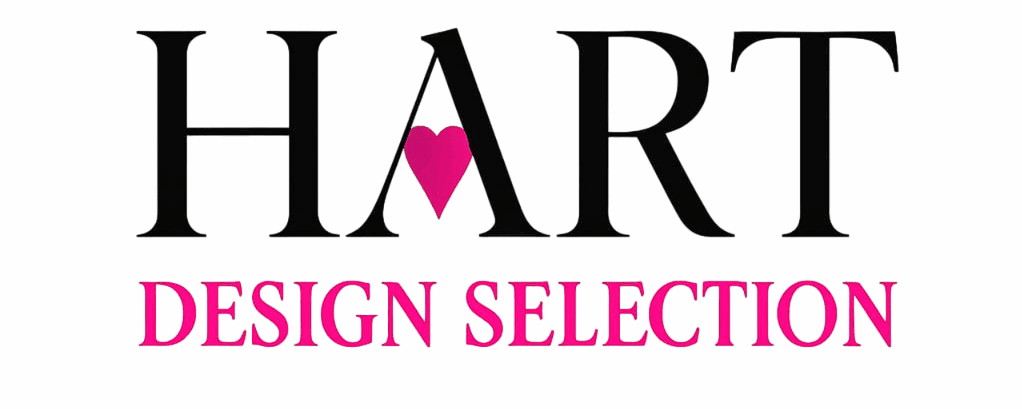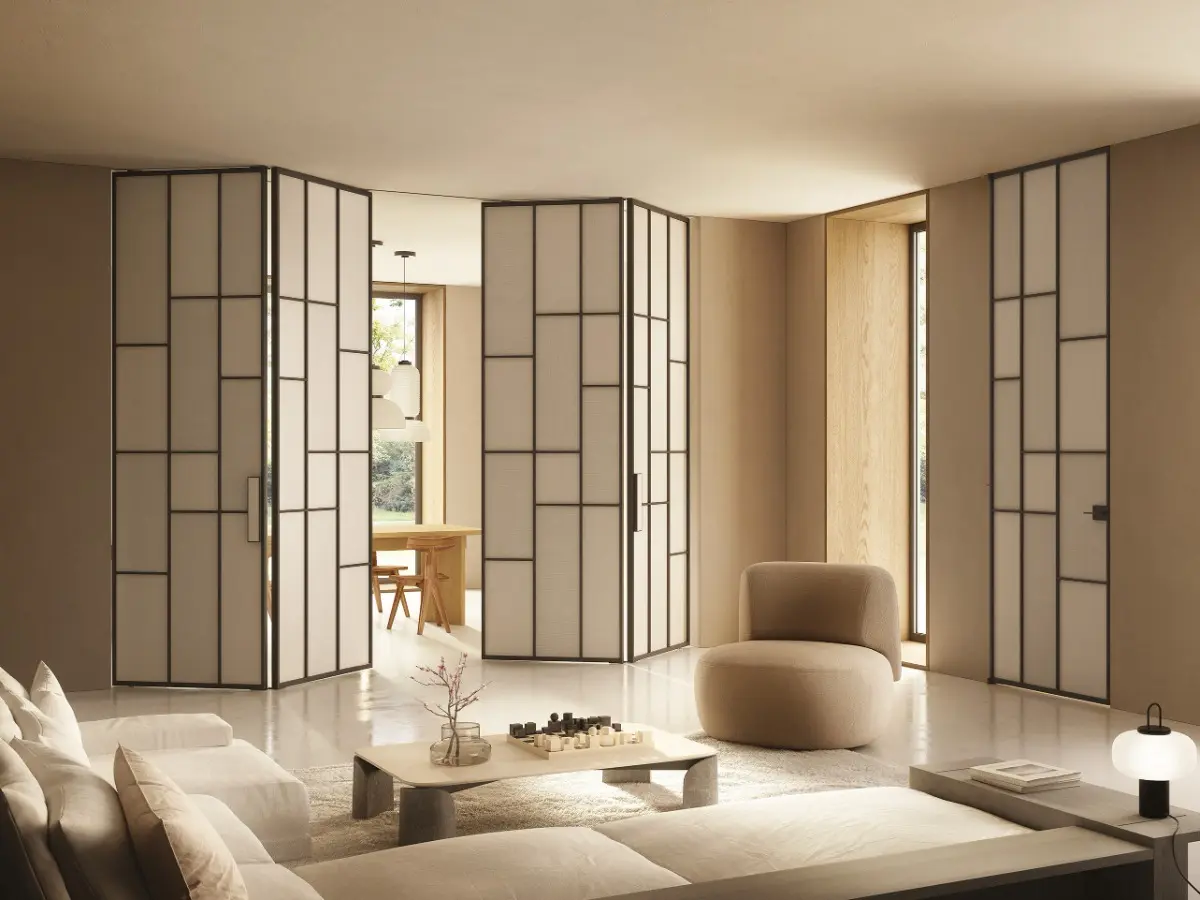Aesthetic mutations redefining contemporary art de vivre
From April 7 to 13, 2025, Milan confirmed its status as the world’s design laboratory, revealing the trends that will shape our interiors. Between Salone del Mobile and Fuorisalone, this year’s event unveiled profound changes: an assertive return to the 70s, the renaissance of contemporary baroque, and the emergence of a silent luxury that redefines the codes of elegance.
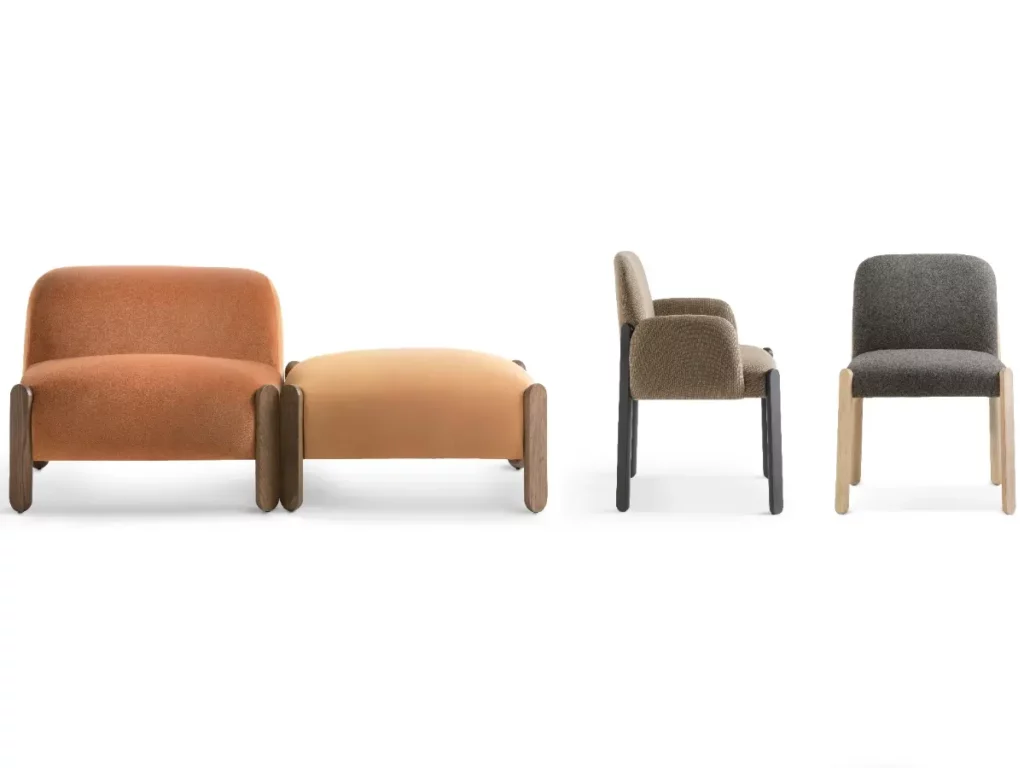
Visionary Creators Redefining Codes
Behind every major trend are daring designers who shake up conventions. Michael Anastassiades revolutionizes modular lighting with his Linked collection, while Garance Vallée creates a sensation with her first collection of furniture combining architecture and poetry. Philippe Malouin fascinates with his folded aluminum creations for Salon 94, manufactured by Donald Judd’s Swiss fabricators.
Creative collaborations marked this edition: Charlotte Macaux Perelman transformed Hermès scenography into a poetic experience, Studio 5.5 teamed up with MUJI for a Japanese microarchitecture, and Pharrell Williams transposed the Humanrace universe into the modular language of USM. This effervescence confirms Milan as the laboratory where international talent meets.
The Great Color Trends: Between Nostalgia and Sophistication
70s Revival: Refined Psychedelia
The pop colors of the ’70s are making a comeback, lighting up the world of Italian design. This renaissance is more than just nostalgia: it’s a sophisticated reinterpretation of the decade’s iconic hues.
Spotlight Colors :
- Burnt orange and mustard yellow revisited
- Olive and sage greens in precious declensions
- Earthy shades, including dark brown, will “boom” this year
Natural and Soothing Palette
Nature-inspired hues such as earthy shades, sage green and ocean blue dominate the new collections. This trend responds to a deep need to reconnect with the natural environment, and organic design remains omnipresent.
Materials: The Renaissance of Noble Craftsmanship
Leather: a remarkable comeback
Leather has made a remarkable comeback, revisited in a contemporary vein, more sensual than rustic. Present in both generous seats and structuring details, it has made its mark in natural hues (tobacco, cognac, sand), often combined with light woods or fine metal structures. This material, synonymous with durability and comfort, expresses a form of tactile intimacy and discreet luxury – a true thread running through collections geared towards well-being and emotion.
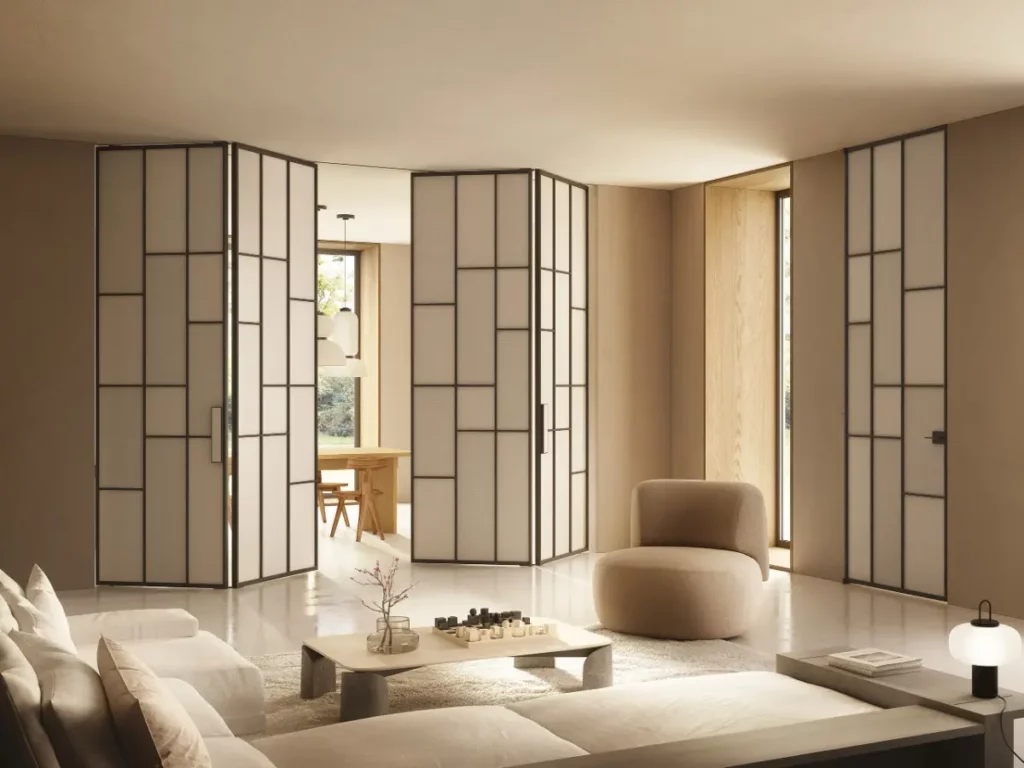
Bamboo: Structure and Poetry
Bamboo makes a comeback, adopting the role of structure with sensitive beauty. Michael Anastassiades presents a collection of modular luminaires on a self-supporting bamboo structure, transforming this material into luminous architecture.
Noteworthy applications :
- Self-supporting structures for luminaires
- Furniture combining bamboo and precious metals
- Sculptural screens with silk prints
Glass and Transparency: The Art of the Fragile
Italian designer Agustina Bottoni unveils her pieces in striated borosilicate glass, hand-crafted by master glassmakers. This trend reveals a fascination with Italian artisanal techniques.
Notable innovations include Miniforms’ blown glass “Soda” tables, in an expanded palette of freer, more playful shapes, still blown in Murano.
Precious Metals: Goldsmiths Revisited
Metalworkers and silversmiths revisit metal and silverware in a coquettish version. Pouenat joins forces with studio Haddou & Dufourcq to create a collection of refined, twisted lines.

Furniture: Revolutions in Usage
L’Art de Vivre Allongé
Milan Design Week 2025 will see an abundance of furniture designed for a life spent lying down. This trend responds to a need for relaxation in our hyper-connected lifestyles. Inspired by the design of the 60s and 70s, space is understood as a system, and the sofa becomes changeable.
Emblematic pieces :
- Acerbis and its 1973 Free System in the spotlight
- XXL beds transformed into living spaces
- Modular sofas for reclining
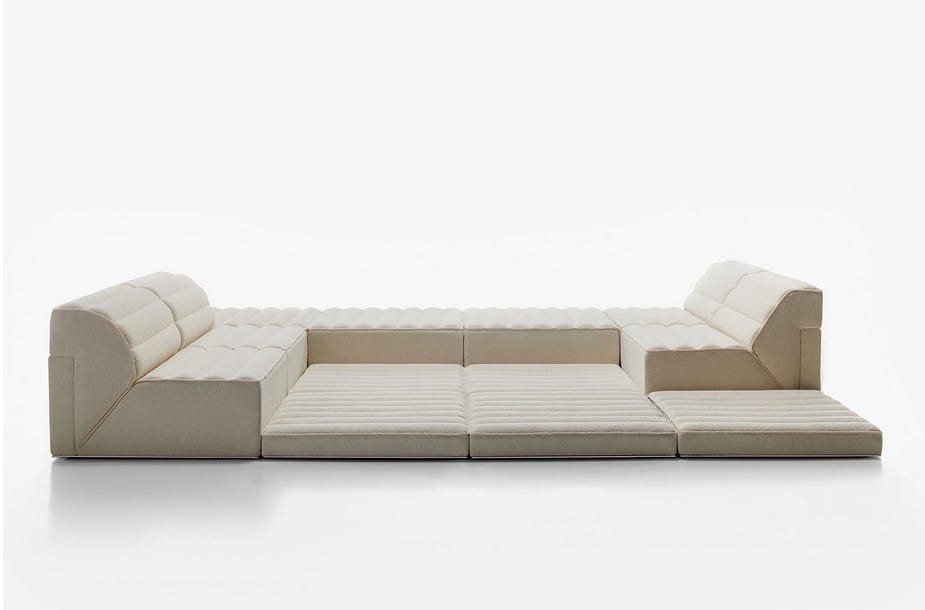
Modularity and adaptability
Modularity becomes the answer to evolving living spaces. USM is working with Pharrell Williams to develop modular furniture – vanities, storage units, hybrid elements – designed for everyday use.
Silent Luxury: The Row
The Row unveils its first collection of textile objects for the home with a stripped-down, radically silent aesthetic. Plaids hand-woven in India, ultra-fine cashmere linen: each piece expresses luxury without ostentation.
Lighting Design: Innovations and Poetry
Sculptural Luminaires
Lighting transcends its utilitarian function to become art. Michael Anastassiades presents Linked, a modular lamp composed of linear borosilicate glass meshes that can be easily connected.
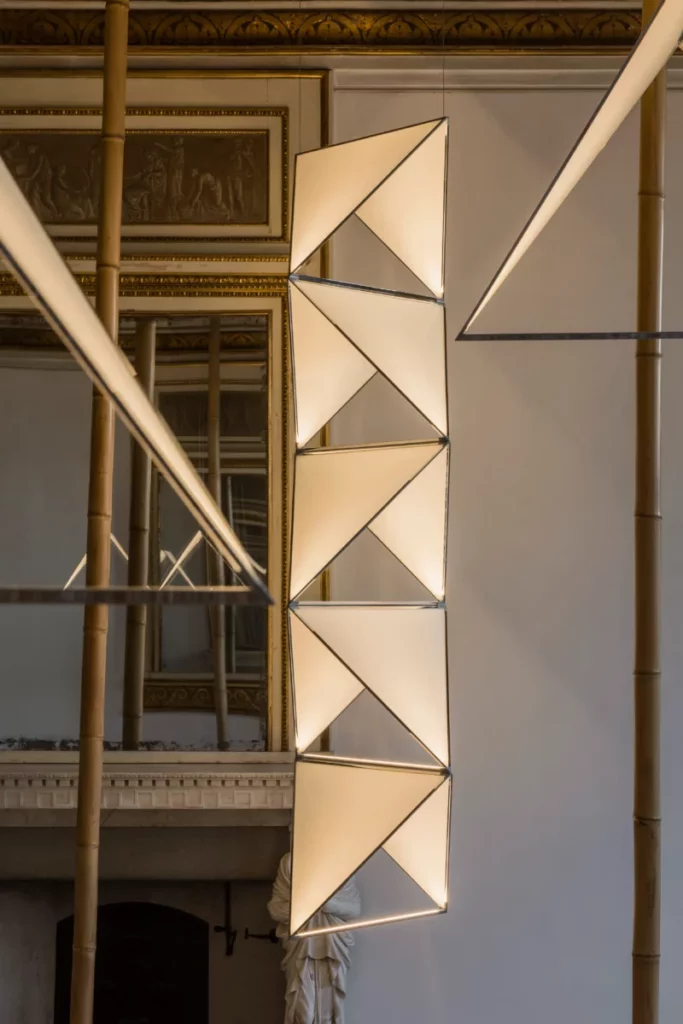
Integrated Technologies
Lasvit presents “Soaked in Light”, an installation that plays on well-being and the link between light and water, with Splash evoking the movements of water sparkling in the sun.
Lifestyle trends: New rituals
Table Art Rethought
The compartmentalized tray is becoming the latest craze in the world of tableware. This trend is inspired by transport meal trays, reinterpreted with sophistication.
Outstanding Innovations :
- Retro-style stainless steel trays
- Collections combining steel and solid walnut
- Reinterpretation of rail and air codes
Fashion-Home collaborations
Fashion houses are investing massively in the art of living:
- Pharrell Williams transposes the Humanrace universe into USM’s modular language
- Charlotte Chesnais brings a jeweled interpretation to Christofle flatware
- Marimekko and Laila Gohar create bed linen sets in cheerful, colorful stripes
Outdoor Indoor: Borders dissolve
Between outdoor furniture manufacturers and special outdoor fabrics, outdoor living is becoming as comfortable as the house itself, and Fermob is exploring the world of interiors for the first time with an indoor collection. The flagship piece is a sofa with signature metal legs and leaf-shaped armrests, symbolizing the dissolution of the boundaries between indoors and outdoors, a major trend for 2025.
Architecture Éphémère: Cultural Installations
Immersion and Experience
Dimorestudio’s installation for Loro Piana: hushed ambience, blood-red velvet curtains and leopard cashmere carpeting. These creations transform product presentation into a total artistic experience.
MUJI and Japanese Aesthetics
MUJI and studio 5.5 inaugurate La Maison Manifeste, a light-wood retreat in a secret garden in Brera. This microarchitecture celebrates the sensitive simplicity of Japanese aesthetics.
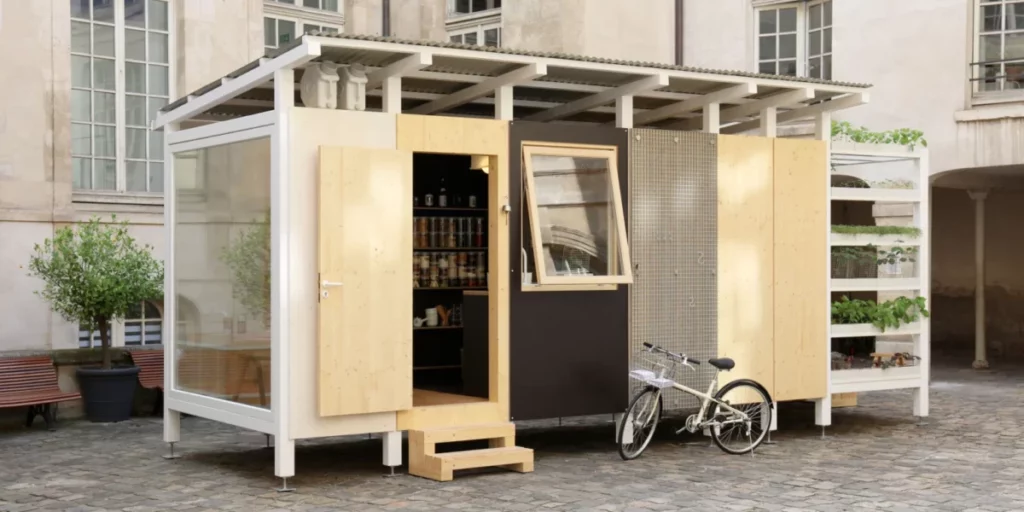
Impact International : Emerging Creators
Global Talents
The international scene is diversifying:
- Laurence Leenaert’s LRNCE unveils Slow Roads, celebrating Moroccan craftsmanship
- Czech duo Dechem Studio presents blown vases combining transparency and pigments
- Botswana designer Peter Mabeo creates the Efo coffee table for Fendi Casa
Foresight: Towards Which Design of Tomorrow?
Integrated sustainability
Natural fibers and recycled materials meet high standards of durability, design and functionality. This approach is no longer a constraint, but a source of aesthetic innovation.
Emotional Intelligence
The objects of 2025 incorporate a psychological dimension, responding to the need for soothing and reconnection. Design becomes therapeutic.
Hybridization of uses
Traditional boundaries are blurring:
- Outdoor/indoor furniture
- Utility/decorative items
- Crafts/technology
Conclusion: Milan, revealing deep-seated changes
Milan Design Week 2025 reveals a sector in the throes of metamorphosis. Over and above aesthetic trends, it reveals a new relationship with objects: more conscious, more sensual, more adaptive.
This edition confirms the emergence of a post-minimalist design that dares to use color, reclaims craftsmanship and celebrates the user experience. Between 70s nostalgia and technological innovation, between quiet luxury and controlled maximalism, Milan 2025 traces the contours of a more authentic and desirable art of living.
Key trends to remember :
- Colors: 70s Renaissance, soothing natural palette
- Materials: Structural bamboo, hand-crafted glass, precious metals
- Furniture: Modularity, extended living, silent luxury
- Lifestyle: Outdoor/Indoor, fashion-house collaborations
- Foresight: Integrated sustainability, emotional intelligence
Milan 2025 is not just about products: it’s about inventing tomorrow’s lifestyles.

Digital entrepreneur and craft artisan, I use my unconventional background to share my vision of luxury design and interior decoration — one enriched by craftsmanship, history, and contemporary creation. Since 2012, I have been working daily in my workshop on the shores of Lake Annecy, creating bespoke interiors for discerning decorators and private clients.
